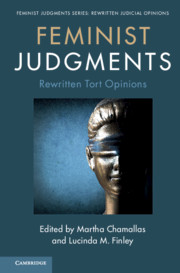Book contents
- feminist judgments: rewritten tort opinions
- Feminist Judgments Series Editors
- Feminist Judgments: Rewritten Tort Opinions
- Copyright page
- Contents
- Notes on Contributors
- Preface
- Table of Cases
- Part I Introduction
- Part II The Classics
- 2 Commentary on Palsgraf v. Long Island Railroad Co.
- 3 Commentary on Escola v. Coca-Cola Bottling Co. of Fresno
- 4 Commentary on Farwell v. Keaton
- 5 Commentary on Tarasoff v. Regents of University of California
- Part III Intentional Torts
- Part IV Negligence and Vicarious Liability
- Part V Damages
- Index
2 - Commentary on Palsgraf v. Long Island Railroad Co.
from Part II - The Classics
Published online by Cambridge University Press: 28 November 2020
- feminist judgments: rewritten tort opinions
- Feminist Judgments Series Editors
- Feminist Judgments: Rewritten Tort Opinions
- Copyright page
- Contents
- Notes on Contributors
- Preface
- Table of Cases
- Part I Introduction
- Part II The Classics
- 2 Commentary on Palsgraf v. Long Island Railroad Co.
- 3 Commentary on Escola v. Coca-Cola Bottling Co. of Fresno
- 4 Commentary on Farwell v. Keaton
- 5 Commentary on Tarasoff v. Regents of University of California
- Part III Intentional Torts
- Part IV Negligence and Vicarious Liability
- Part V Damages
- Index
Summary
Widely regarded as the most celebrated case in US tort law, Palsgraf v. Long Island R.R. Co. denied recovery to a woman who was injured in an explosion while she was standing on a platform waiting for a train. Famed jurist Benjamin Cardozo used the occasion to announce the “zone of danger” test which denies recovery to plaintiffs who are outside the scope of foreseeable harm. The rewritten feminist dissent criticizes Cardozo’s approach for its subjectivity and underlying gender and class bias, charging that Cardozo employed a double standard, displayed a lack of sympathy for the plaintiff, and ignored well-established principles of common law. Rather than using an abstract relational concept of negligence, the feminist dissent focuses on the real relationships among the parties and faults the railroad for encouraging risky masculine behavior on the part of its employees. The accompanying commentary recounts the little-known history of the litigation and discusses the larger social, political, and economic context.
- Type
- Chapter
- Information
- Feminist Judgments: Rewritten Tort Opinions , pp. 27 - 53Publisher: Cambridge University PressPrint publication year: 2020

